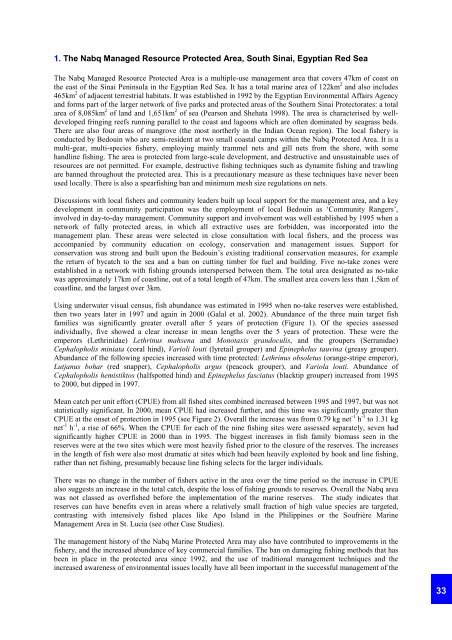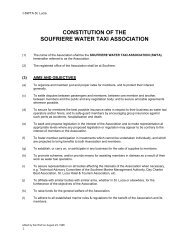WWF Cover photo - Soufriere Marine Management Association ...
WWF Cover photo - Soufriere Marine Management Association ...
WWF Cover photo - Soufriere Marine Management Association ...
You also want an ePaper? Increase the reach of your titles
YUMPU automatically turns print PDFs into web optimized ePapers that Google loves.
1. The Nabq Managed Resource Protected Area, South Sinai, Egyptian Red SeaThe Nabq Managed Resource Protected Area is a multiple-use management area that covers 47km of coast onthe east of the Sinai Peninsula in the Egyptian Red Sea. It has a total marine area of 122km 2 and also includes465km 2 of adjacent terrestrial habitats. It was established in 1992 by the Egyptian Environmental Affairs Agencyand forms part of the larger network of five parks and protected areas of the Southern Sinai Protectorates: a totalarea of 8,085km 2 of land and 1,651km 2 of sea (Pearson and Shehata 1998). The area is characterised by welldevelopedfringing reefs running parallel to the coast and lagoons which are often dominated by seagrass beds.There are also four areas of mangrove (the most northerly in the Indian Ocean region). The local fishery isconducted by Bedouin who are semi-resident at two small coastal camps within the Nabq Protected Area. It is amulti-gear, multi-species fishery, employing mainly trammel nets and gill nets from the shore, with somehandline fishing. The area is protected from large-scale development, and destructive and unsustainable uses ofresources are not permitted. For example, destructive fishing techniques such as dynamite fishing and trawlingare banned throughout the protected area. This is a precautionary measure as these techniques have never beenused locally. There is also a spearfishing ban and minimum mesh size regulations on nets.Discussions with local fishers and community leaders built up local support for the management area, and a keydevelopment in community participation was the employment of local Bedouin as ‘Community Rangers’,involved in day-to-day management. Community support and involvement was well established by 1995 when anetwork of fully protected areas, in which all extractive uses are forbidden, was incorporated into themanagement plan. These areas were selected in close consultation with local fishers, and the process wasaccompanied by community education on ecology, conservation and management issues. Support forconservation was strong and built upon the Bedouin’s existing traditional conservation measures, for examplethe return of bycatch to the sea and a ban on cutting timber for fuel and building. Five no-take zones wereestablished in a network with fishing grounds interspersed between them. The total area designated as no-takewas approximately 17km of coastline, out of a total length of 47km. The smallest area covers less than 1.5km ofcoastline, and the largest over 3km.Using underwater visual census, fish abundance was estimated in 1995 when no-take reserves were established,then two years later in 1997 and again in 2000 (Galal et al. 2002). Abundance of the three main target fishfamilies was significantly greater overall after 5 years of protection (Figure 1). Of the species assessedindividually, five showed a clear increase in mean lengths over the 5 years of protection. These were theemperors (Lethrinidae) Lethrinus mahsena and Monotaxis grandoculis, and the groupers (Serranidae)Cephalopholis miniata (coral hind), Varioli louti (lyretail grouper) and Epinephelus tauvina (greasy grouper).Abundance of the following species increased with time protected: Lethrinus obsoletus (orange-stripe emperor),Lutjanus bohar (red snapper), Cephalopholis argus (peacock grouper), and Variola louti. Abundance ofCephalopholis hemistiktos (halfspotted hind) and Epinephelus fasciatus (blacktip grouper) increased from 1995to 2000, but dipped in 1997.Mean catch per unit effort (CPUE) from all fished sites combined increased between 1995 and 1997, but was notstatistically significant. In 2000, mean CPUE had increased further, and this time was significantly greater thanCPUE at the onset of protection in 1995 (see Figure 2). Overall the increase was from 0.79 kg net -1 h -1 to 1.31 kgnet -1 h -1 , a rise of 66%. When the CPUE for each of the nine fishing sites were assessed separately, seven hadsignificantly higher CPUE in 2000 than in 1995. The biggest increases in fish family biomass seen in thereserves were at the two sites which were most heavily fished prior to the closure of the reserves. The increasesin the length of fish were also most dramatic at sites which had been heavily exploited by hook and line fishing,rather than net fishing, presumably because line fishing selects for the larger individuals.There was no change in the number of fishers active in the area over the time period so the increase in CPUEalso suggests an increase in the total catch, despite the loss of fishing grounds to reserves. Overall the Nabq areawas not classed as overfished before the implementation of the marine reserves. The study indicates thatreserves can have benefits even in areas where a relatively small fraction of high value species are targeted,contrasting with intensively fished places like Apo Island in the Philippines or the Soufrière <strong>Marine</strong><strong>Management</strong> Area in St. Lucia (see other Case Studies).The management history of the Nabq <strong>Marine</strong> Protected Area may also have contributed to improvements in thefishery, and the increased abundance of key commercial families. The ban on damaging fishing methods that hasbeen in place in the protected area since 1992, and the use of traditional management techniques and theincreased awareness of environmental issues locally have all been important in the successful management of the33



